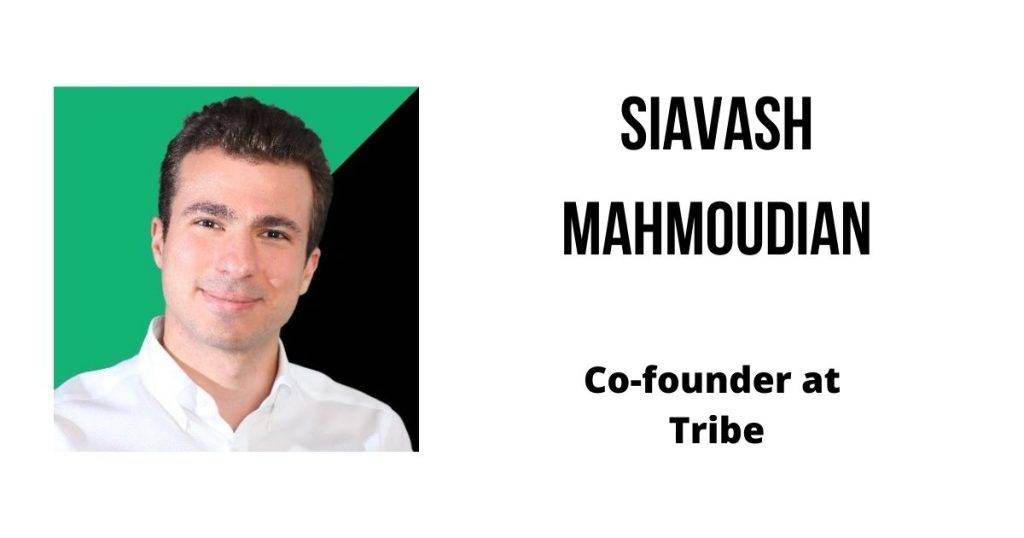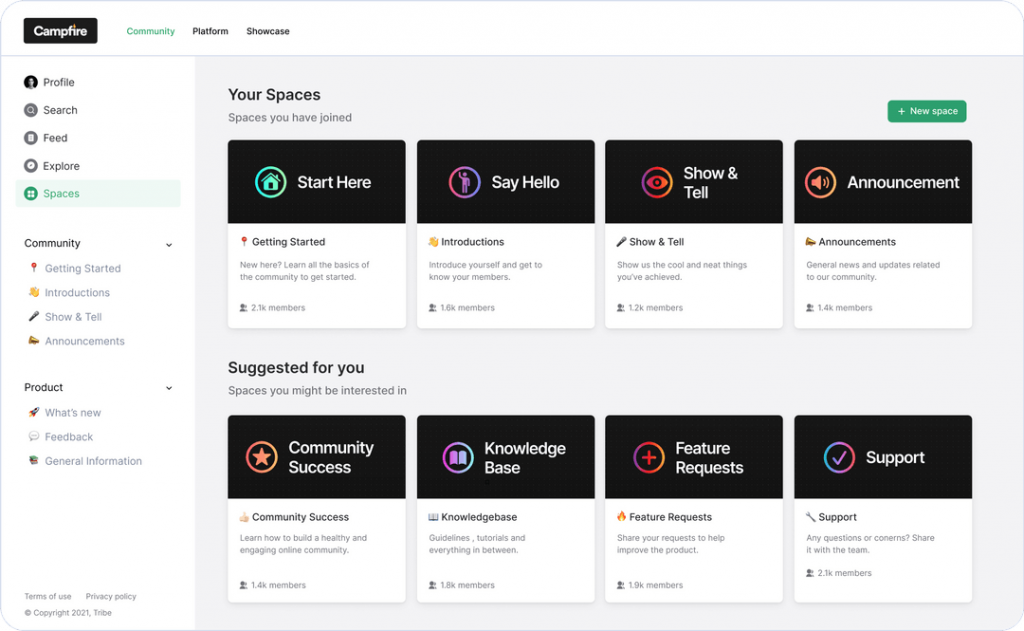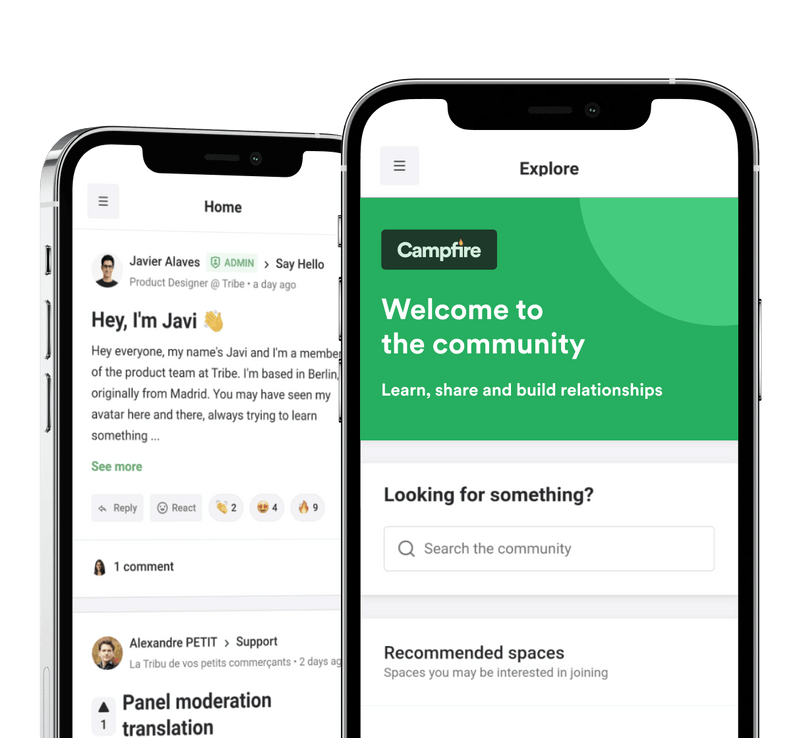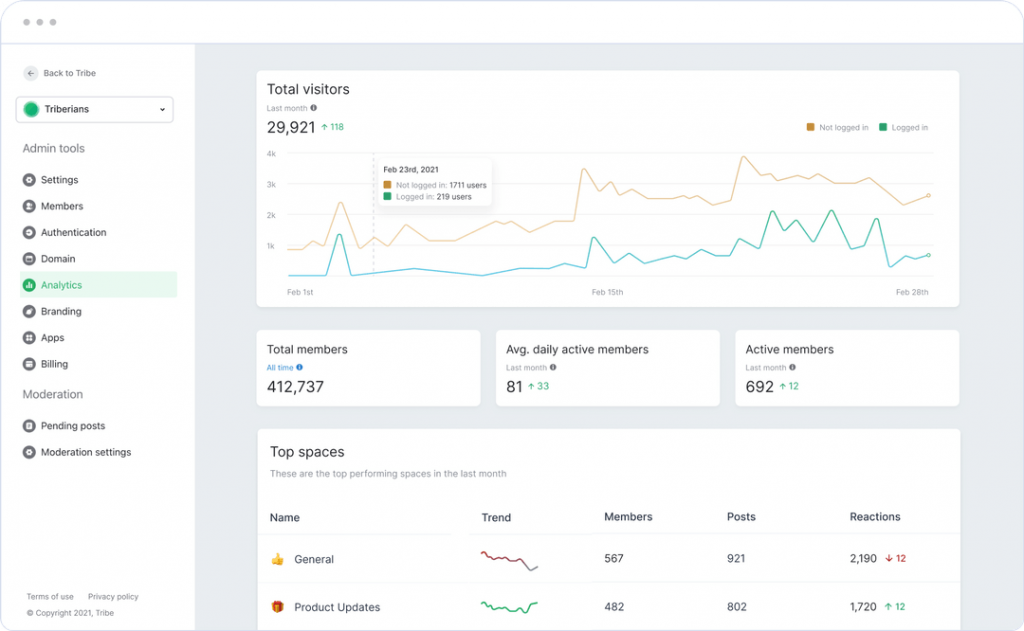We’ve heard about the product-led growth phenomenon for a while now. But have you heard about community-led growth? That’s the next wave for a lot of SaaS companies as they are thinking about unlocking growth opportunities. But how do you go about building a community? First and foremost is to use a software that enables you to bring users of your product together. While there have been software out there for enabling something like this, there aren’t many that are cloud-based, and let you manage the community end-to-end. Enter Tribe, which is doing exactly that. We managed to catch up with its co-founder Siavash Mahmoudian about his journey, the evolution of Tribe from a side project, and how this space will evolve in the future.
PS: the interview has been edited for brevity purposes.

Table of Contents
1) Before we talk about Tribe, could you share your journey into the world of SaaS?
So I’m the technical CEO at Tribe. Initially, I started by just building products when I was a kid. I started programming when I was nine or 10 years old with programming languages that were prevalent at that time. I built a few products that were used by hundreds and thousands of users. One was actually a dating site. Another it was a Yahoo Messenger chatbot where people could actually find experts using Yahoo messenger.
For more than half of my age, I was just building online communities around different things. Earlier, it was just by using all these old products such as forum software like the vBulletin and phpBB. And every single time that I wanted to build an online community, I had to customize it for my needs. Now I was lucky because I was a programmer. I could actually modify the open-source code to make it towards the needs of my audience. However, building an online community is maybe like 90 percent around building the sense of belongingness and building the network, and 10 percent about the technology. The problem was that there weren’t really good solutions out there to handle the technology piece. As a result, many people actually use most of their time on building the technology rather than building the community. Now, I’m originally Iranian and all this story that I told you up until now was when I was in Iran. After finishing school, I immigrated to the states on a work permit and I joined a SaaS company.
This company was around online collaboration. Their customers were like Verizon and all these big organizations. After two years, I was thinking again to go back to the original love that I had for building communities. How can I make it easier? I co-founded a company, and it was an online community software. The initial customers were really large organizations like NASA, the State of Maryland, and other such large organizations. Although it was a SaaS product, when you have really large organizations as customers and most of your revenue is out of those, when they tell you to add this tiny button somewhere, you have to do it for them.
Soon it became a custom shop for these large organizations, and I’ve learned a few things there. The first thing was that every single community has different needs and you cannot just reuse the same thing if it’s just a regular software for two communities. And if you want to be a SaaS business, that’s the whole point of it – you want to do something that more and more people can use without lots of custom development. The second part was that I figured that many of these companies wanted the community experience to be in the product that they already have. So they already have some sort of portal for their audience, but they don’t have the social capabilities. They cannot just connect to each other. Now, these were like the two really big learnings out of it.
I immigrated to Canada three years ago and I built this side project of mine based on the learnings that I had previously. And the main result of it was to build a platform rather than a software. What does it mean? It means that we as Tribe handle all the hard problems for building a very customizable social network. We handle the feed, the notifications, the analytics, moderation, chat, and all of those things. But everything else is an app built on top of our product. Even for ourselves, when we want to build something new on top of Tribe, we use our own platform and we build on top of it. We don’t have a backdoor. So a good example of this is iOS. Like iOS has a weather app, but a third party can actually come and build a better weather app on top of iOS. That’s the same thing for us. Like Zoom integration is an app, Q&A is an app, the discussion is an app – everything is an app. And all integrations like Salesforce, HubSpot, Intercom, Amplitude are apps too. And then we build it on top of our own platform. We’ve built Tribe in a way that it’s a platform that’s customizable and extensible. And also it’s very easy to embed it, so it’s embeddable. These are the three main pillars of the DNA of Tribe.
So I was running this as a side project. Randomly, two of my oldest friends also immigrated to Canada at the same time. They said that this side project looks good, let us sell and market it, and we started doing it. And in two weeks we had customers wanting to pay us $300 per month and we didn’t have a bank account. That’s when we actually co-founded the company, and started collecting money. And that’s the story of Tribe and my journey into the world of SaaS.
2) What gaps did you see in the market before launching Tribe?
First of all, the need for building communities has been around since human beings are there. We had ‘tribes’ back in time. The purpose of that at that time was survival. Of course, the communities and the need for them have evolved over time. So the idea behind Tribe is to bring people together so they can help each other. So if we can actually help 10,000 community managers helping 10,000 members. That’s a 100million people impact and we can actually do that. That’s the beauty of it.
When you actually try to help others to help others. The reasoning behind why there needs to be another tool out there. If you look into the pillars that I’ve mentioned above – customizability, extensibility, and embeddability – and if you look at the market, there is no product that has all three of these and is a platform.
We have software like Slack, but that is for internal communication and it’s an amazing app. But it’s not built for building communities. And we do see people building actually communities on it, but soon after, they actually want to migrate to somewhere else, because it doesn’t have the moderation, and the pricing does not work either. On the other side, we have Facebook Groups, it’s an amazing product. But you don’t own your content, or you don’t own your users. You cannot build on top of it either, or customize it any further. You cannot even control how the notifications go out. So it’s an amazing product to actually initiate a community. But if you’re a business, then it’s not the best solution. And for that reason, we have many other clients that came from Facebook Groups to find a better environment for their audience to be connected together. There are many different products out there that want to handle communities, but the ones that are customizable are rare. Technically, there are custom shops, just like my previous company. But they are pretty expensive. They see each of these as a separate product. As a result, If you want to think about a platform that is all those three items, and serving small and medium-sized businesses, there’s not much around. And it’s 2021. Why does it take so much time to customize your community and the experience when the user enters it? In fact, we have many of our customers that embedded Tribe into their phone app because you don’t want for instance, a Pipedrive app and a Pipedrive Community app. You want the community to be a tab inside your product. Not many products are embeddable into the user’s experience. But we provide all these features through SDKs that we give, and an easy-to-use embeddability functionality.
You can copy a product, but you cannot copy a community.
One last thing is that this is the best time for attacking this market. I’ve been building communities for so long, and there was never such a demand. Even really big brands who should already have a community, now actually want to start one. And the reasoning is that because the community is the moat. Some businesses actually are community-first, while some are community-led. It’s similar to the data-driven trend back in time, everyone wants to focus on communities now. You can copy a product, but you cannot copy a community. In essence, you cannot copy that sense of belongingness. That’s what makes your product stickier than the most successful companies you see out there.
Tribe is a platform that empowers developers to build new functionalities, using low code to empower more no-code entrepreneurs.
3) How has Tribe evolved since its inception?
In its initial days, Tribe was just a side project. At that time, we faked everything. We faked being a platform. We faked being extensible. We had an app store, but it was super hard to build new apps. And we were using back channeling of our own products.

So we used to just build things inside the code and then package it as an app. But then we learned some things. We learned that if we empower our community, all the customers, audience, or fans, they will help us build on top of what we need. There is no real platform out there for them to do that. As an example, in the first version of our product, we had around 50 apps, and 35 percent of those apps were built by our community. Although it was super hard to build apps on top of Tribe back in time. We had to talk to them, and do a lot of back and forth, and it’d take like three months. Another example is that our customers translated Tribe into 30 different languages. And we haven’t hired anyone to translate. Our community did it and is still maintaining it. That’s very interesting for us as some languages that I haven’t even heard of their name, we support it.
The reason was that we empowered our community to do that. Now the biggest change is that we raised our seed round around 10 months ago. The purpose was to basically move ahead and not fake lots of this stuff. So we rebuilt the whole product. That’s a long journey until we can get to all the features that we had on the first version. But this time we wanted to make sure that we really build something that is a platform and it’s scalable, extensible, and all those things. Now that we have this promise-market fit and not a product-market fit, we wanted to build on that promise. That’s the biggest change over time.
Of course, the team has grown a lot. Now we’re not building a product. We’re building a company, and building a ‘tribe’ internally, so we can actually support our extended tribe.
4) What’s the current numbers like for Tribe? How many customers do you have now?
Every single day, there are around 200 to 300 new communities being built on top of Tribe. We’re empowering around 8 to 9 million end users, which are our customer’s customers basically. So far we have ~100k communities built on top of Tribe. Of course, not all of them are active.
5) Are there any specific type of sectors that are using Tribe more?
When we launched Tribe, the top of the funnel was pretty open. We served everyone to figure out what’s the best place to start. We learned that we should serve businesses. And when I talk about businesses. For instance, if you want to build a book club for moms, well, that’s not our customers. Most likely, they should use WhatsApp or Telegram, or Facebook Groups for that. However, if you are a business and when I talk about business, I don’t mean only companies. I mean, you can also be an influencer that has more than some amount of followers. That’s a business. Like they are actually earning money from that job. So if you are a business, Tribe should be able to serve you. Not maybe right now, but in the future.
So that’s the market we’re going after – businesses. Initially, the target audience that we are targeting are SaaS and small and medium-sized businesses. So if you are a business that has more than 200 customers or audience, then you’re most likely a good fit. And the way we provide that is that we make sure that you can design the best environment for your audience to be connected. So that’s what we do. We help bring people together so they can help each other. We let you build the best type of environment for your audience because it’s different for everyone. For example, if you are a school and you want to connect your students, it’s very different from even when you’re at school and you want to connect with your teachers. And compared that to if you’re a SaaS business and you want to connect your employees, maybe in some cases, and in some other cases you want to connect to your customers.
6) Could you shed a light on your marketing strategy?
First of all, we are an inbound company, and we don’t do much outbound. There is the reasoning behind it because it’s really hard to convince a company that you need a community, and Tribe is the platform you should use.

We should find them when they’re really searching for such a software. And right now, it’s the best time again, because everyone is searching for things like how do I increase our stickiness of the product, how do I make sure we have more ambassadors of the product, or how do we want to reduce the support cost. All those things in the end leads you to the fact that you need a community. So it’s a really good time for that. And more than 60 percent of our marketing efforts are organic. So most of these communities that I’ve mentioned are being built every day. When you’re searching for a community platform, you’d land on Tribe. We are on the top three results most likely on Google. Similarly, if you’re searching for alternatives to Facebook groups, alternatives to slack, building a support community, building a success community, etc, we would again be among the top results. So we double down on the hard thing, which is building tons of really useful content. And the content that we’re building isn’t just marketing content. These are things that we have learned over a long period of time. These are just experiences. It’s like something that we onboard our own employees using those. So those are pretty insightful content. So we double down a lot on that. And then of course we have the usual marketing channels. Every quarter, we try three new channels, and then figure out which ones are working, and the ones that aren’t working, we reiterate or retry them after nine months after to see if there is a change there. The review sites also give us good leads that we can actually utilize. Of course, we have things like Google Adwords, Facebook, YouTube, and all those things. But, if you go on the end result of how much revenue they bring in, the organic ones are bringing better revenue.
7) Considering you’ve been in this space for so long, how has this space evolved over time?
Well, one of the biggest changes is that the member expectation has changed a lot. Previously, people used to use forum software, and they were fine with it. But now, when they see Instagram, Facebook, Quora – their expectation from an online community has changed. And I think, that’s part of the reason that we see lots of new players around in this category. That’s because, the software that are out there right now, the leading community platforms have been there for 15 years, and there haven’t been lots of innovations in this space. But right now, because of that expectation, and businesses understanding the power of community, we’re seeing a lot more demand in this market – as much as 10x. Now for most companies or businesses, you don’t need to convince them that you need the community. They already know they need a community. They just don’t know how to build it.
8) What does future hold for Tribe? Any new features that you are working on?
Our focus is mostly on customer-to-customer communication. So if you see Intercom, it’s an amazing product. In fact, one of their co-founders is among our angel investors and Intercom is mostly customer-to-employee communication. So it helps customers to chat with you. Then we have other systems like Slack, which is employee-to-employee communication. So what we want to tackle is customer-to-customer communication, and then having employees in the middle. In the future, most likely we should provide some CRM functionalities, because it’s just another way of getting these customers inside your systems. And the idea is like we should be super integratable with other platforms. So for instance, as the admin of the community, if I go on a user profile, I should be able to see how many emails we have sent to this user on HubSpot. Similarly, one should be able to see how much we are earning out of this customer in Salesforce right there, in their user profile. And if I want to create a ticket out of one of the problems that they had in the community, I should be able to post it easily to Zendesk right from there. So that is the idea that is where we want to go.
Intercom is customer-to-employee communication, and Slack is employee-to-employee communication. Tribe enables customer-to-customer communication with employees in the middle.
As mentioned before as well that building a community isn’t about technology… it’s about building that sense of belongingness. And that’s what we’re focusing the most on Tribe as a long-term strategy to figure out how the product can teach these companies about how to launch and how to build a community. How can we give them the best insights and the best actions that they can do without using a customer success manager or a human? Now when you use Notion, for instance, or when you use PowerPoint, the templates, the presets that you use, they teach you to utilize a new framework to build your Wiki, to build your documentation system. So how can we also teach by action in the product? So if you want to build a support community, here’s the structure that you should use. And here’s how you should onboard people. Many brands, when they want to launch their community, they just invite all their customers and after that, nobody returns. But building a community is not like that. Building the community is something you should invite your friends for. That’s why hobby communities are the most successful ones because they start with friends, fans, inner circle, and then, they expand.
9) What are the biggest challenges for you right now?
I think the biggest challenge that we have right now is defining what we are and what we are not. When I think about Tribe in long term, it’s like Shopify for building communities. Or another example is that we are a no-code social product builder. Now, if you think of it that way, it’s actually very hard to figure out what people should be able to build using Tribe and what is not us anymore, because technically, we can be a social commerce platform if you want. Technically, you can become a CRM. So the biggest question is how much we want to expand. We need to clearly define what we are and what we aren’t.

The second challenge is that I believe that we know what our customers want. We’ve been doing this for a while. We are behind on the product on what we should deliver to our customers. And this velocity of creating things in a way that is not fixed, because the new version is being built slower than the previous product, because we’re not just adding everything as toggles and checkboxes and text box. We want to build things in a way that we foresee the future. So if another thing needs to be built on top of it, how does it work? If you’re thinking about gamification, gamification is not only things that we can build, we should think about how your customers can build something. For example, your customer buys something in Shopify. You want them to earn some virtual currency in the community or earn some reputation score, or perhaps get a certain badge. Like how would these work together? So that’s the reason we’re taking our time… to be able to balance between moving fast and building things that are scalable,
10) What are your favorite SaaS software out there?
I’m going to name the software that we use the most. I’d say Notion is top of my list. We are a fully distributed company, and for async communication, writing is the most important thing. We also are using Loom a lot for async videos. Figma did an amazing job to make product design way more collaborative and easier compared to Photoshop. Of course, there’s Slack for internal communication.






